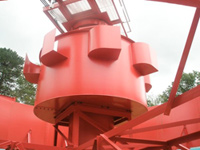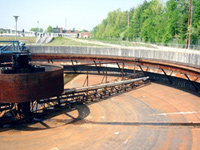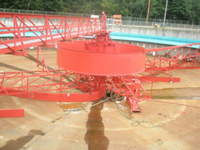

Mid-AtlanticDownload a pdf for your convenience. Project Description:A large (50-mgd) municipal plant was experiencing extreme wet weather flows. It's three 145-ft draft tube clarifiers had been down-rated to handle only a total flow of 32-mgd. There was good flow control established for two of the clarifiers. The project objectives were to (a) conduct a full field evaluation of the clarifiers, and (c) make recommendations for improvements. Findings:The field evaluation showed that at 10-mgd, the clarifiers were near failure at 24 mg/l. However, subsequent tests at 14- and 18-mgd produced markedly better performance with ETSS less than 10 mg/l! There were two distinct problems: first, at all flows, it was apparent that the solids were not being settled in the center of the clarifiers; secondly, it was shown that, at the lower (10-mgd) flow, there was not enough energy from the incoming flow (Q + R) to effectively mix in the centerwell. This resulted in an increase in the density current ... and a deterioration of the effluent quality. However, as the flow (and incoming energy) was increased, the clarifiers performed remarkably well. Recommendations:To improve the influent conditions, we recommended the use of an energy-dissipating inlet (EDI) that would address the entrance problems inherent in a draft tube clarifier (because of the location of the RAS sight box). We also recommended the installation of a Crosby cylindrical baffle. Subsequent Actions:Two years later, the clarifiers were in the process of being upgraded with a standard tangential-port EDI, a submerged centerwell, and spiral scrapers when a rain event occurred. Two of the clarifiers had been upgraded but the third clarifier was still a draft tube clarifier. The two new clarifiers failed ... lost their blankets ... but the old clarifier produced an effluent of less than 10 mg/l! CPE Services, Inc. was again brought in to evaluate the clarifiers and compare the new configuration with the original configuration. Findings 2:First, we had the submerged centerwell raised above the water surface. This single modification reduced the average ETSS from 24 mg/l to 7 mg/l. Even with the improved centerwell, though, the new clarifier lost it's blanket at 700 gal/sf/d ..... while the old clarifier was still producing an ETSS of 7 mg/l! The Problem:The contract had specified the use of the LA-EDI or equal. The manufacturer employed a CFD model analysis to convince all that his tangential port EDI was superior to the LA-EDI. This tangential port configuration was then shown by our field analysis to have caused a stirring of the entire contents of the clarifier; this stirring motion led to their premature failure. The Solution:A subsequent brainstorming session generated several ideas for reducing the problems caused here by the tangential port EDI: inserting an additional interior baffle in the EDI, drastically enlarging the EDI openings, and adding vertical baffles to the centerwell. The combination of these modifications finally enabled the new clarifiers to match the performance of the old clarifier. What Did We Learn?:CFD modeling can produce erroneous projections. All EDIs are certainly not "equal". Most notably, however, the "tangential port" or "scooped" EDI configuration has been documented once again to be the sole cause of a clarifier's failure. Click for larger images:  
|